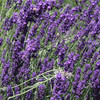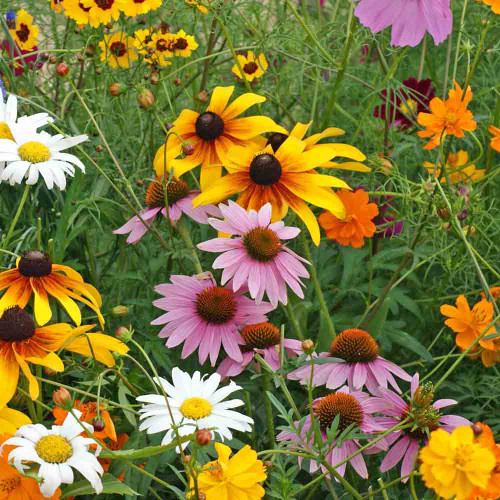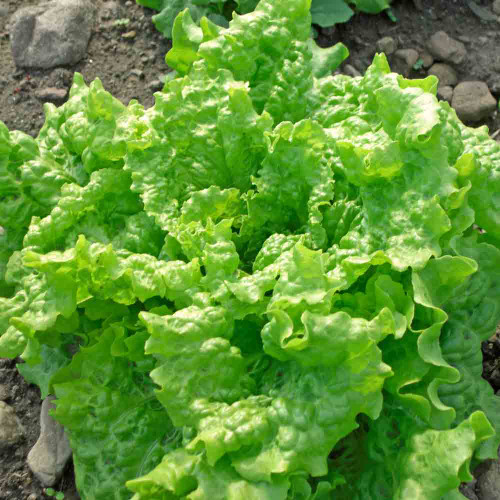Description
English Lavender - Discover the Secrets of this Ancient Herb
English lavender is renowned for its sweet, floral scent, often considered the purest and most versatile among lavender varieties. It's no wonder that this beloved herb has graced gardens and homes for centuries. But this cherished gem offers so much more than just a pretty flower; it's a feast for the eyes and a symphony of fragrance and a treasure trove of possibilities, easily grown from seed at home. Discover the secret to growing the most prized lavender, and unlock a world of lavender luxury in your backyard.
Details
This variety typically grows into a mounded shape, reaching 1 to 3 feet in height and 2 to 4 feet in width. When planted in groups or rows, the mounded plants look like soft, billowing clouds of silvery-green foliage. Its narrow, evergreen leaves add year-round interest to the garden. In summer, it bursts into bloom, producing striking flower spikes adorned with small, tubular flowers in shades of purple, lavender, or white. This plant delights the senses and has almost endless uses; a sea of lavender blooms that washes over you, soothing and inviting a few moments of quiet.
This low-maintenance perennial thrives in sunny, well-drained locations, making it a perfect choice for home gardeners. Sweet, floral notes with a hint of earthy spice fill the air when the lavender blooms, creating an intoxicating fragrance that is both calming and invigorating—reminiscent of a summer stroll through the French countryside. This delightful scent is perfect for enjoying in the garden or drying for use in potpourri, sachets, and crafts. The stunning purple flowers and silvery-green foliage add a tapestry of colors and textures that dance in the summer breeze.
As a multi-purpose plant, lavender effortlessly transitions from a culinary herb enhancing your favorite dishes to a fragrant oil soothing your senses in a relaxing bath, to a potent addition to your medicinal cabinet – you'll be amazed at the sheer variety of ways you can use lavender! The fragrant flowers attract bees and butterflies, supporting biodiversity in your garden. Hardy in USDA Zones 5-9, it can withstand cold temperatures, ensuring years of enjoyment in your garden. Once established, it requires minimal care, shrugging off drought and resisting most pests and diseases. And as a bonus, you'll be doing your part to support a healthy ecosystem by providing valuable habitat and food sources for pollinators.
History
Lavender's story is as rich and fragrant as the herb itself. Centuries ago, the ancient Egyptians incorporated lavender into their elaborate embalming rituals, seeking to preserve not only their pharaohs' bodies but also the captivating scent of this revered herb. The Romans, renowned for their appreciation of fragrance, enthusiastically adopted lavender, adding it to their baths, using it in cooking, and even believing in its healing and antiseptic properties. This belief was not without foundation, as we know from the Greek military physician Dioscorides, who in 77 AD documented lavender's various medicinal uses. He noted its effectiveness in relieving indigestion, headaches, sore throats, and its external applications for treating wounds, burns, and skin ailments.
Roman soldiers, undoubtedly influenced by Dioscorides's writings, carried lavender on their campaigns to dress their wounds. Lavender's uses extended beyond the battlefield; they were strewn on floors to sweeten the air, fumigated sick rooms, and even burned as incense for religious ceremonies. The Roman author and naturalist Pliny the Elder also recognized lavender's therapeutic benefits, writing about its effectiveness in treating various ailments, from menstrual problems to upset stomachs and insect bites.
Lavender's journey continued through the Middle Ages, where it was cultivated in monastery gardens and prized for its medicinal properties. It was even believed to offer protection against the plague! During the 16th century, lavender's popularity blossomed in England, gracing the gardens of royalty and common folk alike. Queen Elizabeth I, a devoted lavender enthusiast, used it to treat her migraines and as a perfume, solidifying its place in English gardens.
Uses
Lavender is a gift that keeps on giving, offering a wealth of uses from garden to kitchen to home spa.
Culinary: The flowers and leaves can be used fresh or dried to flavor dishes, beverages, and desserts. Imagine the delicate floral aroma of lavender infusing your homemade ice cream or shortbread cookies. You can also create lavender sugar for baking or add the fragrant buds to your favorite herbal tea blend. It's also a classic ingredient in Herbes de Provence.
Aromatic: Lavender oil is prized in aromatherapy for its calming and relaxing properties. Create a spa-like experience at home by adding a few drops to your bath or creating a soothing massage oil.
Garden: Lavender deters pests, attracts beneficial insects, and adds fragrance to the air. It can even be used to freshen carpets or deter fleas from pet bedding.
Companion Planting
This lavender is a generous companion plant, enhancing the garden for many other species:
Beneficial Pairings: Lavender thrives alongside rosemary, sage, yarrow, marigolds, roses, thyme, coneflower, garlic, and basil. These pairings often benefit both plants, deterring pests, attracting pollinators, or improving growth.
Antagonistic Pairings: Avoid planting lavender near mint, hostas, and camellias, as they prefer different growing conditions.
Planting and Growing Tips
To ensure your English lavender flourishes, give it the sunny home it loves. Choose a spot that receives at least 6-8 hours of direct sunlight daily. Well-drained soil is essential, so amend with sand or gravel if necessary. Avoid overly rich soil, as this can lead to excessive foliage growth at the expense of flowers.
Water regularly during the first growing season to help your lavender establish a strong root system, but it's quite drought-tolerant once established. Prune lightly in early spring or after flowering to maintain shape and promote bushier growth.
A layer of gravel or small stones as mulch will keep the roots cool and dry, improving drainage and preventing moisture from accumulating around the base of the plant. Consider using rock mulch instead of organic mulch in areas with high humidity to reduce moisture further. In colder climates, provide a sheltered location and some winter protection to help your lavender withstand harsh winter conditions.
Growing Lavender from Seed
Growing English lavender from seed is easier than you might think, and you'll have the satisfaction of nurturing your fragrant lavender plants from the beginning. To mimic the natural winter conditions that lavender seeds experience, it's best to give them a head start with cold stratification. Simply place your seeds in a moist paper towel in a sealed bag and pop them in the refrigerator for 30-40 days.
When you're ready to sow, use a well-draining seed-starting mix – a blend of sand and seed-starting compost works well. Sow the seeds directly on the soil's surface, misting gently to avoid displacing them. Remember, lavender seeds need light to germinate, so don't cover them with soil.
Provide a warm environment with temperatures around 70°F and ensure the seedlings receive 8-10 hours of sunlight per day. Once your seedlings have at least two sets of true leaves, you can transplant them into individual pots or outdoors, spacing them about 12 inches apart.
Growing lavender from seed requires a bit of patience – germination can take up to 30 days, and you may not see flowers until the following year. But the reward of nurturing a lavender plant from its earliest stages is well worth the wait.
Harvest Tips
For the best flavor and fragrance, harvest lavender flowers in the morning after the dew has dried. Cut long stems and gather them in bunches to dry out of direct sunlight for several days.
Learn More
- Lavender Soothes Animals Too
- The Versatility of Herbes de Provence
From the soil to the seed to the food you eat - we'll help you grow your best garden!

















